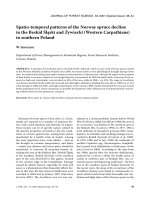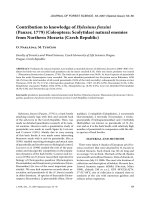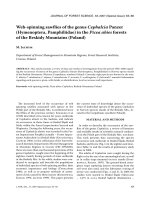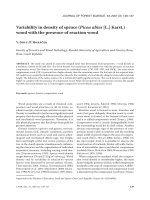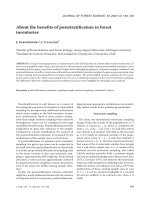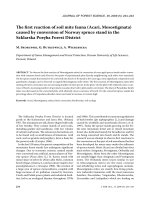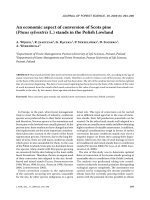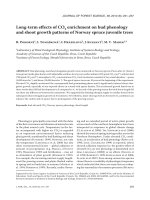Báo cáo lâm nghiệp: "Contribution to knowledge of Hylesinus fraxini (Panzer, 1779) (Coleoptera: Scolytidae) natural enemies from Northern Moravia (Czech Republic)" pdf
Bạn đang xem bản rút gọn của tài liệu. Xem và tải ngay bản đầy đủ của tài liệu tại đây (198.63 KB, 4 trang )
J. FOR. SCI., 53, 2007 (Special Issue): 53–56 53
JOURNAL OF FOREST SCIENCE, 53, 2007 (Special Issue): 53–56
Contribution to knowledge of Hylesinus fraxini
(Panzer, 1779) (Coleoptera: Scolytidae) natural enemies
from Northern Moravia (Czech Republic)
O. N, M. T
Faculty of Forestry and Wood Sciences, Czech University of Life Sciences Prague,
Prague, Czech Republic
ABSTRACT: Predation by natural enemies was studied as mortality factors of Hylesinus fraxini in 2006–2007. Pre-
dation by birds was not recorded and predation rate by insect reached 0.1%. Only one insect predator was reared
– anasimus formicarius (Linnaeus, 1758). e total rate of parasitism was 54.0%. At least 8 species of parasitoids
from the order Hymenoptera were recorded. e most abundant parasitoid was Eurytoma morio Boheman, 1836
(44.1% from the total number of all reared parasitoids; 23.8% of the total mortality), subsequently Eurytoma arctica
omson, 1876 (31.7%; 17.1%), Cheiropachus quadrum (Fabricius, 1787) (12.8%; 6.9%), Braconidae (6.3%; 3.4%),
Rhaphitelus maculatus Walker, 1834 (3.9%; 2.1%), Mesopolobus sp. (0.5%; 0.3%), were not identified Pteromalidae
(0.5%; 0.3%) and Tetrastichus sp. (0.2%; 0.1%).
Keywords: predators; parasitoids; natural enemies; bark beetles; Hylesinus fraxini; anasimus formicarius; Cheiro-
pachus quadrum; Eurytoma morio; Eurytoma arctica; Czech Republic; Central Europe
Hylesinus fraxini (Panzer, 1779) is a bark beetle
attacking mainly logs with thin and smooth bark
of the ash-trees in the Czech Republic. Here, was
made no detailed quantitative research of its natu-
ral enemies. However such a quantitative study of
parasitoids was made in south Spain by L
and C (1991). Mainly due to easy rearing
of this bark beetle it was made some interesting
bionomic study with it and its parasitoids. M
(1991) studied searching strategies and attack rates
of parasitoids and its relevance to biological control.
L et al. 1994 studied the role of the para-
sitism and intraspecific competition in the popula-
tion dynamics of the bark beetle. C and L-
1994) on H. fraxini researched reproductive
biology of Cheiropachus quadrum (Hymenoptera:
Pteromalidae) and Dendrosoter protuberans (Hym.:
Braconidae) (its two of the most important para-
sitoids). We may find numerous records about as-
sociation and parasitoids of the H. fraxini mainly
in older literature. 16 species of braconids (Hyme-
noptera: Braconidae), 12 pteromalids (Hym.: Ptero-
malidae), 2 eulophids (Eulophidae), 2 eurytomids
(Eurytomidae), 2 torymids (Torymidae), 1 tricho-
grammatids (Trichogrammatidae) and 1 bethylids
(Bethylidae) are known as parasitoids of H. fra-
xini and so it is the bark beetle with relatively high
number of parasitoids in comparison with the oth-
er species of bark beetles.
MATERIAL AND METHODS
ere were taken 4 chunks of European ash (Fra-
xinus excelsior) that were attacked by H. fraxini in
Central Moravia. Each chunk was 50 cm long and
on average 7.6 cm thick. e bark of the all chunks
was smooth and without fissures. Date of chunk col-
lection was July 12, 2006. e exact site location of
collection and description of habitat: Moravia bor.,
Litovel, faunistic square (6268c) (P, M
1996), altitude 230 m a.s.l., GPS 49°42'26.42''N,
17°4'17.88''E, site of collection is situated close to
outskirts of the city with numerous gardens and
solitary urban vegetation.
54 J. FOR. SCI., 53, 2007 (Special Issue): 53–56
e attacked chunks were moved under the labo-
ratory conditions, subsequently individuals of bark
beetles with their predators and parasitoids were
reared. Predators and chalcid wasps were identified
to species (some problematic chalcids only to genus)
and braconids only to families. All specimens were
identified by authors and revised by Vladimír Kalina
(Faculty of Forestry and Wood Sciences, Czech Uni-
versity of Life Sciences Prague, Czech Republic).
At first bark surface was evaluated with respect
to predation of birds. Subsequently, the rate of the
predation was estimated in the following way. Pre-
dation was counted as ratio of bark damaged by
birds and total bark area with galleries. e influ-
ence of insects’ predation and parasitoids on the
total population of the bark beetle was calculated
on base of the following mathematic relations.
Presumptions of utilize mathematic relations is
that one individual of parasitoid or predator will
kill only one bark beetle larvae (it does not have to
be in case of predators).
REARING RESULTS
Rearing results are given in Table 1, where are re-
corded counts of males and females for all species
of chalcid wasps parasitoids. Braconids sex was not
discovered because these were not identified to the
species. Table 1 also shows taxonomic positions
and associations with H. fraxini for all species.
Percentage rates of total predation (together birds
and insects), total parasitism and total mortality of
bark beetles H. fraxini for single species are given
in Table 2.
Table 1. e results of rearing: species, taxomonic position of the species, association with H. fraxini and count of emerged
individuals
Species Taxonomic position Association Count of ♀ Count of ♂ In total
Cheiropachus quadrum
(Fabricius, 1787)
Hymenoptera: Pteromalidae parasitoid 60 46 106
Rhaphitelus maculatus
Walker, 1834
Hymenoptera: Pteromalidae parasitoid 22 10 32
Mesopolobus sp. Hymenoptera: Pteromalidae parasitoid 0 4 4
Not identified
Pteromalidae
Hymenoptera: Pteromalidae parasitoid – – 4
Tetrastichus sp. Hymenoptera: Eulophidae parasitoid 2 0 2
Eurytoma morio
Boheman, 1836
Hymenoptera: Eurytomidae
parasitoid,
hyperparasitoid
140 226 366
Eurytoma arctica
omson, 1876
Hymenoptera: Eurytomidae
parasitoid,
hyperparasitoid
155 108 263
? Hymenoptera: Braconidae parasitoid ? ? 52
anasimus formicarius
(Linnaeus, 1758)
Coleoptera: Cleridae predator – – 2
Hylesinus fraxini
(Panzer, 1779)
Coleoptera: Scolytidae host – – 706
∑ emerged parasitoids individuals
Mortality
parasitism
= 100%
(∑ em. predators individuals + ∑ em. parasitoids ind. + ∑ em. bark beetles ind.)
∑ emerged predators individuals
Mortality
insect predation
= 100%
( ∑ em. predators individuals + ∑ em. parasitoids ind. + ∑ em. bark beetles ind.)
Mortality
total
= (Mortality
parasitism
+ Mortality
insect predation
) × (1 – Mortality
birds
) + (Mortality
birds
)
J. FOR. SCI., 53, 2007 (Special Issue): 53–56 55
DISCUSSION
J (1957) mentioned birds (woodpeck-
ers) like significant natural enemies of this species
of bark beetle but especially during the winter sea-
son. In case of this study birds do not participate on
mortality of bark beetle hence they kill 0% of bark
beetle population.
Activity of woodpeckers was not probably re-
corded due to date of taking of chunks under labo-
ratory condition (July).
Very small importance has insect predators. ere
was recorded only one species of predator – ana-
simus formicarius L. (Coleoptera: Cleridae), which
consumed only 0.1% of bark beetle population.
Parasitoids kill 53.9% of bark beetle population.
ere were recorded 4 species of parasitoids from
family Pteromalidae, 1 species of Eulophidae, 2 Eury-
tomidae and some Braconidae (see Tables 1 and 2).
is parasitoid complex is relatively rich and count
at least 8 species of parasitoids from the order Hy-
menoptera. L and C (1991) made
similar study in south Spain and they recorded only
5 species. In this experimentation was the most
abundant parasitoids Eurytoma morio Boheman
(44.1% from total count of all reared parasitoids)
which killed 23.8% of bark beetle population. e
second abundant parasitoid was Eurytoma arctica
omson (31.7% reared parasitoids, caused 17.1%
mortality). However in fact these data do not predi-
cate number of killed bark beetle larvae. E. morio
as well as E. arctica are able to act like primary
parasitoids (B et al. 1953; N 1957;
H 1963; P 1976, hyperparasit-
oids (S 1952; N 1957) but also
like kleptoparasitoids (M 1991). Both species
are mainly known as hyperparasitoids of braconids,
because of this it is more suitable to merge braco-
nids and both hyperparasitoids into one group
amounting 82.1% from total count of all reared
parasitoids and causing the death to 44.3% of bark
beetle population.
L and C (1991) recorded braco-
nids Dendrosoter protuberans (Nees, 1834) as the
most effective parasitoid, which counted 51.9%
reared parasitoids and caused 12.7% mortality of
bark beetle population. ey also recorded hyper-
parasitic species Eurytoma morio and E. aloisifilip-
poi (Russo, 1938) – but here they did not affect in
so insignificant range on bark beetles. In case of
this study the rate of braconids and hyperparasit-
ic species was exactly the opposite. It seems that
braconids may be very effective natural enemies
of H. fraxini, but their effectivity is inversely pro-
portionally depended on presence and abundance
of eurytomids. ese hyperparasitoids in reality
do not affect parasitism height of just developing
bark beetle larvae (if they affect only as hyperpara-
sitoids) or they increase parasitism height (if they
affect at least partly as primary parasitoid). In both
cases they decrease a number of primary parasit-
oids – able to attack a next bark beetle generation.
Cheiropachus quadrum was the most effective pri-
mary parasitoid from superfamily Chalcidoidea
(counted 12.8% reared parasitoids and caused 6.9%
mortality of bark beetle population).
is study showed total parasitism 53.9%. is
exceeded two-time more, what have published L-
Table 2. Percentage rates: on total predation, on total parasitism and on total mortality of bark beetles H. fraxini
Species
Total rate of predation caused
by insects and by birds (%)
Rate of total number
emerged parasitoids (%)
Total rate of H. fraxini
mortality (%)
Cheiropachus quadrum (Fabricius, 1787) – 12.8 6.9
Rhaphitelus maculatus Walker, 1834 - 3.9 2.1
Mesopolobus sp. – 0.5 0.3
Not identified Pteromalidae – 0.5 0.3
Tetrastichus sp. – 0.2 0.1
Eurytoma morio Boheman, 1836 – 44.1 23.8
Eurytoma arctica omson, 1876 – 31.7 17.1
Braconidae – 6.3 3.4
anasimus formicarius (Linnaeus, 1758) 100.0 – 0.1
Birds 0.0 – 0.0
Hylesinus fraxini (Panzer, 1779) (host) – – 45.9
56 J. FOR. SCI., 53, 2007 (Special Issue): 53–56
and C (1991) who have recorded para-
sitism 22%. On the other hand J et al. (2002
researched mortality factors of Hylesinus oleiperda
(Fabricius, 1792), related bark beetle to H. fraxini
which is also developing on Fraxinus excelsior L.,
and they recorded parasitism rate to 70%.
Total mortality caused by birds (0.0%), by preda-
ceous insect (0.1%) and by parasitoids (54.0%) was
54.1% hence vital bark beetles – able to base new
generation – survived 45.9%.
Ref erenc es
BOUČEK Z., PULPÁN J., ŠEDIVÝ J., 1953
. Notizen über
die parasitischen Hymenopteren des Fichtenborkenkäfers
Ips typographus L. in CSR. Folia Zoologica Entomologica,
2: 148.
CAMPOS M., LOZANO C., 1994
. Observations of the re-
productive biology of two parasites of Hylesinus varius and
Phloeotribus scarabaeoides (Col.: Scolytidae): Cheiropachus
quadrum (Hym.: Pteromalidae) and Dendrosoter protube-
rans (Hym.: Braconidae). Entomophaga, 39: 51–59.
HEDQVIST K.J., 1963.
Die Feinde der Borkenkäfer in Schwe-
den. I. Erzwespen (Chalcidoidea). Studia Forestalia Suecica,
11: 1–176.
JAMNICKÝ J., 1957.
Prirodzení nepriatelia jaseňovca pes-
trého (Leperisinus fraxini Panz.) a možnosť ich využitia
v boji proti nemu. Bratislava, SAV, Biologické práce, 3:
1–66.
JARDAK T., MOALLA M., KSANTINI M., 2002
. Mortal-
ity factors affecting populations dynamics of the scolytid
Hylesinus oleiperda Fabr. (Coleoptera, Scolytidae). Acta
Horticulturae, 586: 823–826.
LOZANO C., CAMPOS M., 1991
. Preliminary study about
entomofauna of the bark beetle Leperisinus varius (Coleop-
tera, Scolytidae). Redia, 74 (3, Appendix): 241–243.
LOZANO C., CAMPOS M., KIDD N.A.C., JERVIS M.A.,
1994. e role of parasitism and intraspecific competition
in the population dynamics of the bark beetle, Leperisinus
varius (Fabr.) (Col., Scolytidae) on European olives (Olea eu-
ropea L.). Journal of Applied Entomology, 117: 182–189.
MILLS N.J.,
1991. Searching strategies and attack rates of
parasitoids of the ash bark beetle (Leperisinus varius) and
its relevance to biological control. Ecological Entomology,
16: 461–470.
NUORTEVA M., 1957
. Zur Kenntnis der parasitischen Hy-
menopteren der Borkenkäfer Finnlands. Suomen Hyön-
teistieteellinen Aikakauskirja, 23: 47–71.
PETTERSEN H., 1976
. Chalcid-flies (Hym., Chalcidoidea)
reared from Ips typographus L. and Pityogenes chal-
cographus L. at some Norwegian localities. Norwegian
Journal of Entomology, 23: 47–50.
PRUNER L., MÍKA P., 1996. Seznam obcí a jejich částí v České
republice s čísly mapových polí pro síťové mapování fauny.
Klapalekiana (Supplementum), 32: 1–115.
SACHTLEBEN H., 1952.
Die parasitischen Hymenopteren
des Fichtenborkenkäfer Ips typographus L. Beiträge zur
Entomologie, 2: 137–189.
Příspěvek k poznání přirozených nepřátel kůrovce Hylesinus fraxini (Panzer,
1779) (Coleoptera: Scolytidae) na severní Moravě (Česká republika)
ABSTRAKT: Byla zjištěna celková mortalita způsobená přirozenými nepřáteli, do které byla započítána predace ptáky,
predace dravým hmyzem a parazitace. Predace ptáky byla zaznamenána ve výši 0,0 %, predace hmyzem 0,1 %, přičemž
byl vychován pouze jeden predátor – anasimus formicarius (Linnaeus, 1758). Celková parazitace dosahovala výše
54,0 % a byla způsobena přinejmenším osmi druhy parazitoidů řádu Hymenoptera. Nejčetnějším parazitoidem byl
druh Eurytoma morio Boheman, 1836 (44,1 % z celkového počtu vylíhlých parazitoidů s 23,8% podílem na celkové
mortalitě), následně Eurytoma arctica omson, 1876 (31,7 %; 17,1 %), Cheiropachus quadrum (Fabricius, 1787)
(12,8 %; 6,9 %), Braconidae (6,3 %; 3,4 %), Rhaphitelus maculatus Walker, 1834 (3,9 %; 2,1 %), Mesopolobus sp. (0,5 %;
0,3 %), nedeterminovaní Pteromalidae (0,5 %; 0,3 %) a Tetrastichus sp. (0,2 %; 0,1 %).
Klíčová slova: predátoři; parazitoidi; přirození nepřátelé; kůrovci; Hylesinus fraxini; anasimus formicarius; Chei-
ropachus quadrum; Eurytoma morio; Eurytoma arctica; Česká republika; střední Evropa
Corresponding author:
Ing. O N, Ph.D., Česká zemědělská univerzita v Praze, Fakulta lesnická a dřevařská,
165 21 Praha 6-Suchdol, Česká republika
tel.: + 420 224 383 738, fax: + 420 224 383 739, e-mail: nakladal@fld.czu.cz

